1949 Jeep Willys, a vehicle that emerged from the ashes of World War II, redefined the landscape of automotive history. This rugged, versatile machine, born from military necessity, quickly found its place in civilian life, becoming a symbol of American ingenuity and adventure.
The 1949 Jeep Willys, with its iconic design and legendary off-road capabilities, carved a path for the modern SUV and left an enduring legacy that continues to inspire.
Its simple yet robust design, featuring a sturdy body, a powerful engine, and a four-wheel drive system, made it an ideal choice for a variety of applications. From farms and construction sites to exploration and military operations, the 1949 Jeep Willys proved its mettle in diverse environments, becoming a trusted companion for countless individuals.
History and Significance
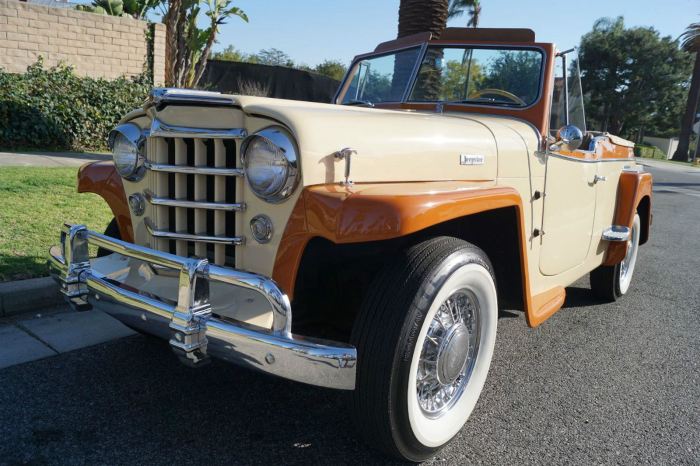
The 1949 Jeep Willys, a vehicle that seamlessly transitioned from the battlefields of World War II to the roads and trails of postwar America, holds a significant place in automotive history. Its rugged design, innovative engineering, and enduring legacy have cemented its position as a timeless icon.
The Legacy of World War II
The Jeep Willys’ origins can be traced back to the urgent need for a versatile, off-road vehicle during World War II. The U.S. Army, seeking a vehicle capable of traversing difficult terrain, issued a set of specifications for a light reconnaissance vehicle.
Several manufacturers responded, but it was Willys-Overland Motors that emerged as the winner with its prototype, the “Quad.” The Quad’s design, featuring a compact size, four-wheel drive, and a powerful engine, proved to be ideal for the war effort.
The Jeep Willys, as it came to be known, became a ubiquitous presence on battlefields around the world, earning a reputation for its reliability, durability, and maneuverability.
Engineering Innovations, 1949 Jeep Willys
The 1949 Jeep Willys incorporated several innovative engineering features that contributed to its success.
- A Compact Design:The Jeep Willys’ short wheelbase and narrow track made it exceptionally maneuverable, allowing it to navigate tight spaces and challenging terrain.
- Four-Wheel Drive:The four-wheel drive system provided superior traction, enabling the Jeep Willys to handle a wide range of driving conditions, from muddy fields to rocky trails.
- A Powerful Engine:The 134-cubic-inch, four-cylinder engine, while small in displacement, generated ample power for the Jeep Willys’ size and weight.
- A Rugged Chassis:The Jeep Willys’ sturdy ladder frame construction and robust suspension system were designed to withstand the rigors of off-road driving.
Impact on the Automotive Industry
The 1949 Jeep Willys’ success had a profound impact on the automotive industry. It popularized the concept of the four-wheel drive vehicle, inspiring other manufacturers to develop their own off-road vehicles. The Jeep Willys’ design and engineering innovations became the foundation for future generations of SUVs and off-road vehicles.
Design and Features: 1949 Jeep Willys
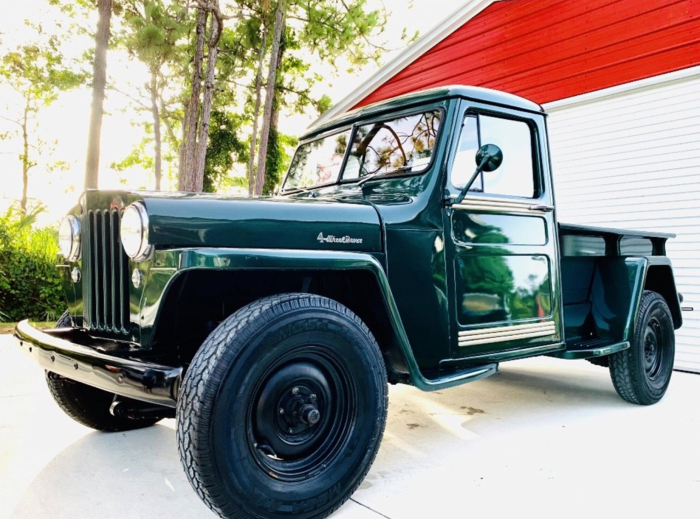
The 1949 Jeep Willys, a vehicle born from the trials of World War II, carried over much of its predecessor’s rugged design while incorporating refinements that made it more suitable for civilian use. Its distinctive features and engineering solutions made it a popular choice for both off-road adventures and everyday transportation.
Body Style and Chassis
The 1949 Jeep Willys retained its iconic, utilitarian body style, featuring a flat-fendered design with a boxy, angular shape. The steel body was mounted on a robust ladder frame chassis, known for its strength and durability. This design ensured excellent ground clearance and off-road capability, allowing the Jeep to navigate challenging terrain with ease.
The chassis also provided a solid foundation for the vehicle’s suspension system, which utilized leaf springs at both the front and rear axles.
Engine and Powertrain
The 1949 Jeep Willys was powered by a 134-cubic-inch (2.2-liter) four-cylinder engine, producing 60 horsepower. This engine, known for its reliability and simplicity, was mated to a three-speed manual transmission. While not particularly powerful by today’s standards, the engine provided adequate power for the Jeep’s relatively light weight and off-road capabilities.
The engine’s simple design also contributed to its ease of maintenance.
Interior and Exterior Features
The 1949 Jeep Willys’ interior was functional and spartan, reflecting its military origins. It featured a simple dashboard with basic gauges and controls. The seats were vinyl-covered and offered minimal padding. The interior was designed for practicality, with features like a removable top and side curtains that provided ventilation and protection from the elements.The exterior of the 1949 Jeep Willys was characterized by its distinctive flat-fendered design, a prominent grille with seven vertical slots, and a spare tire mounted on the rear tailgate.
The vehicle’s overall design was functional and robust, reflecting its intended purpose as a versatile and durable vehicle.
Comparison with Other Vehicles
Compared to other vehicles of its time, the 1949 Jeep Willys stood out for its off-road capabilities and rugged durability. While passenger cars of the era emphasized comfort and style, the Jeep was designed for utility and practicality. Its high ground clearance, robust chassis, and four-wheel drive system made it a formidable off-road vehicle, capable of traversing terrain that would have been impassable for other vehicles.However, the 1949 Jeep Willys also had its limitations.
Its engine lacked power and fuel efficiency, and the interior was spartan and lacked the amenities found in contemporary passenger cars. Nonetheless, the Jeep’s unique combination of ruggedness, versatility, and affordability made it a popular choice for a wide range of applications, from farming and construction to recreational activities.
Performance and Capabilities
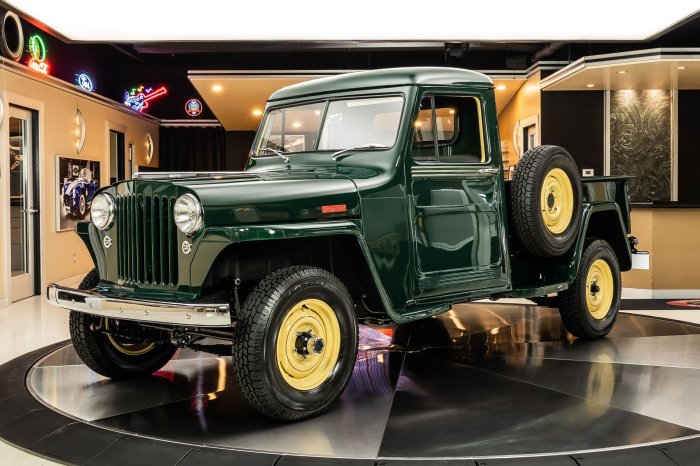
The 1949 Jeep Willys, despite its compact size and modest engine, was surprisingly capable and versatile. Its performance characteristics and off-road capabilities made it a popular choice for a wide range of applications, from farming and construction to military operations.
The 1949 Jeep Willys was a popular choice for its ruggedness and versatility. It was a direct descendant of the original World War II Jeep, the 1941 Jeep Willys , which helped shape the future of off-road vehicles. The 1949 model retained many of the original’s features, but it was refined with a more powerful engine and updated styling.
Engine Performance
The 1949 Jeep Willys was powered by a 1.6-liter, four-cylinder engine, commonly known as the “Go Devil.” This engine produced 60 horsepower at 4,000 revolutions per minute (RPM) and 90 lb-ft of torque at 2,000 RPM. While these figures may seem modest by today’s standards, they were sufficient for the Willys’ intended purpose.
The engine was known for its ruggedness and reliability, making it suitable for demanding conditions.
Fuel Efficiency
The 1949 Jeep Willys achieved a respectable fuel efficiency for its time. It was estimated to get around 15-20 miles per gallon on the road. This was a significant advantage, especially in the post-war era when fuel was scarce and expensive.
Off-Road Capabilities
The 1949 Jeep Willys was designed with off-road performance in mind. Its key features included:
- High Ground Clearance:The Willys had a generous ground clearance of 8.5 inches, allowing it to navigate over rough terrain with ease.
- Solid Axles:The use of solid axles provided durability and strength, essential for handling uneven terrain.
- Four-Wheel Drive:The Willys’ four-wheel drive system provided exceptional traction and climbing ability, allowing it to tackle challenging off-road conditions.
- Low Gear Ratios:The transmission offered low gear ratios, providing ample torque for climbing steep hills and pulling heavy loads.
Real-World Applications
The 1949 Jeep Willys was a workhorse in various industries and sectors:
- Farming:Farmers used the Willys for tasks like plowing, hauling, and transporting supplies. Its compact size and maneuverability made it ideal for navigating tight spaces and uneven fields.
- Construction:Construction workers relied on the Willys for hauling materials, towing equipment, and accessing remote work sites. Its off-road capabilities proved invaluable in challenging terrain.
- Military Operations:The Willys served as a versatile vehicle in the Korean War, providing transportation, reconnaissance, and light artillery support. Its ruggedness and off-road capabilities made it well-suited for combat conditions.
Legacy and Impact
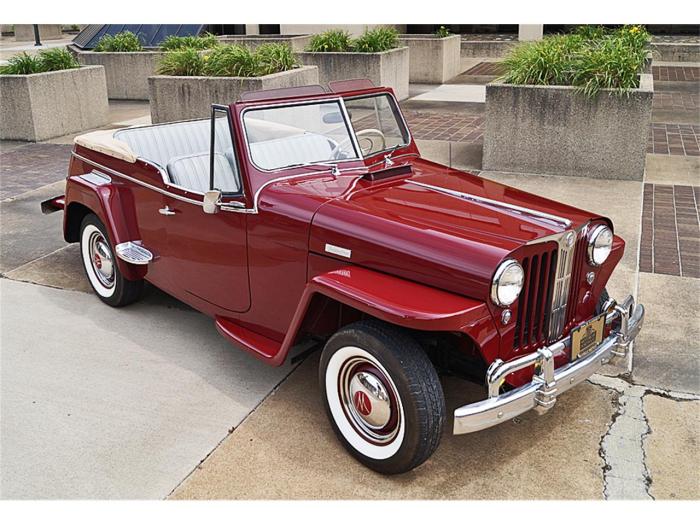
The 1949 Jeep Willys, a vehicle born out of wartime necessity, left an indelible mark on the world, influencing not only the automotive industry but also popular culture. Its rugged design and off-road prowess captured the imagination of the public, making it a symbol of adventure, freedom, and resilience.The 1949 Jeep Willys’ legacy extends beyond its practical applications, with its presence felt in various forms of media.
The Jeep Willys in Popular Culture
The Jeep Willys’ iconic design and enduring appeal have made it a frequent fixture in movies, television shows, and literature.
- The Jeep Willys’ ruggedness and versatility made it a popular choice for films set in war-torn environments, such as “The Dirty Dozen” (1967) and “Saving Private Ryan” (1998), where it was used as a military vehicle.
- In the television series “M*A*S*H” (1972-1983), the Jeep Willys served as a vital mode of transportation for the medical personnel in the Korean War, highlighting its reliability and adaptability.
- The Jeep Willys’ enduring popularity is evident in its continued presence in modern media, with appearances in films like “Indiana Jones and the Kingdom of the Crystal Skull” (2008) and “The Avengers” (2012), where it is often depicted as a vehicle capable of handling challenging terrains.
The Evolution of the Jeep Brand
The 1949 Jeep Willys laid the foundation for the Jeep brand’s evolution, with its ruggedness, reliability, and off-road capabilities becoming synonymous with the brand.
- Over the years, the Jeep brand has expanded its product line, introducing models like the Cherokee, Wrangler, and Grand Cherokee, each building upon the core values established by the original 1949 Willys.
- The Jeep brand has continued to innovate, incorporating modern technology and safety features while maintaining its commitment to off-road performance and durability, reflecting the legacy of the 1949 Willys.
- Today, Jeep remains a globally recognized brand, with a diverse range of vehicles catering to a wide spectrum of driving needs, all while honoring the spirit of the original 1949 Willys.
The Jeep Willys’ Influence on the Modern SUV
The 1949 Jeep Willys is considered a pioneer in the development of the modern SUV, with its rugged design and off-road capabilities paving the way for the modern off-road vehicle market.
- The 1949 Willys’ compact size, high ground clearance, and four-wheel drive system provided a template for future SUVs, emphasizing versatility and capability in challenging terrains.
- The Jeep Willys’ success in both military and civilian applications demonstrated the potential of a vehicle that could navigate rough terrain and provide a comfortable ride, influencing the design and features of subsequent SUV models.
- The Jeep Willys’ influence can be seen in the design of modern SUVs, which often incorporate features like high ground clearance, four-wheel drive, and rugged exterior styling, all of which were pioneered by the 1949 Willys.
Collecting and Restoration

Owning and restoring a 1949 Jeep Willys is a rewarding experience for automotive enthusiasts. It allows you to connect with a piece of history and enjoy the ruggedness and simplicity of a classic vehicle. This section will guide you through the process of acquiring and restoring a 1949 Jeep Willys, providing tips for identifying genuine vehicles, sourcing parts, and understanding the factors that influence their value.
Identifying Genuine Vehicles
Authenticity is crucial for collectors. Here are some key aspects to consider when verifying the genuineness of a 1949 Jeep Willys:
- VIN Number:The Vehicle Identification Number (VIN) is a unique identifier for each vehicle. The VIN for a 1949 Jeep Willys is typically located on the driver’s side dashboard, near the windshield. It should consist of 17 characters and be consistent with the model year.
You can cross-reference the VIN with historical records to verify its authenticity.
- Engine and Transmission:The original engine for a 1949 Jeep Willys is a 134 cubic inch, four-cylinder engine, commonly referred to as the “Go Devil.” The transmission is typically a three-speed manual. Inspecting these components for originality and matching serial numbers can help confirm the vehicle’s authenticity.
- Body and Chassis:The body and chassis of a 1949 Jeep Willys are characterized by their distinctive design elements. The body should have a flat windshield, a rounded hood, and a simple, utilitarian design. The chassis should have a rigid frame construction and a solid axle suspension.
Look for signs of alterations or modifications that may indicate a non-original vehicle.
- Documentation:Original documentation, such as the owner’s manual, service records, and historical photos, can provide valuable insights into the vehicle’s history and authenticity. If possible, try to obtain documentation that matches the VIN number.
Availability of Parts and Resources
Restoring a 1949 Jeep Willys requires access to parts and resources. Fortunately, a robust network of suppliers and enthusiasts cater to the restoration needs of vintage Jeep Willys owners.
- Specialty Parts Suppliers:Numerous companies specialize in providing parts for classic Jeeps. These suppliers offer a wide range of components, from engine and transmission parts to body panels and interior trim. Some reputable suppliers include Kaiser Willys, Jeep Parts Source, and Quadratec.
- Online Marketplaces:Online marketplaces like eBay and Craigslist offer a vast selection of parts for vintage Jeeps. You can find both new and used parts from various sellers. Be sure to research the seller’s reputation and the condition of the parts before making a purchase.
The 1949 Jeep Willys was a workhorse, known for its ruggedness and versatility. It paved the way for future Jeep models, like the 1961 Jeep FC-150 , which took the off-road capabilities to another level with its forward-control design. While the FC-150 was a step forward in terms of functionality, the 1949 Willys remains a classic, representing the birth of the iconic Jeep brand.
- Jeep Clubs and Forums:Joining Jeep clubs and forums can connect you with a community of enthusiasts who can provide valuable advice, parts recommendations, and restoration tips. These platforms often have dedicated sections for parts trading and classifieds.
Value and Appreciation
The value of a 1949 Jeep Willys varies depending on its condition, originality, and historical significance. Well-preserved and restored examples can command significant prices.
- Condition:The condition of a 1949 Jeep Willys is a primary factor influencing its value. Vehicles in excellent condition, with original paint, interior, and mechanical components, are highly sought after. Vehicles that have been restored to factory specifications are also valued highly.
- Originality:Vehicles that retain their original components and features are generally more valuable than those that have been modified or restored with aftermarket parts. A vehicle with a documented history of ownership and maintenance can also add to its value.
- Historical Significance:Vehicles with a unique or notable history, such as those used in military service or significant events, can command premium prices. Vehicles with original documentation or provenance can also increase their value.
Visual Representations
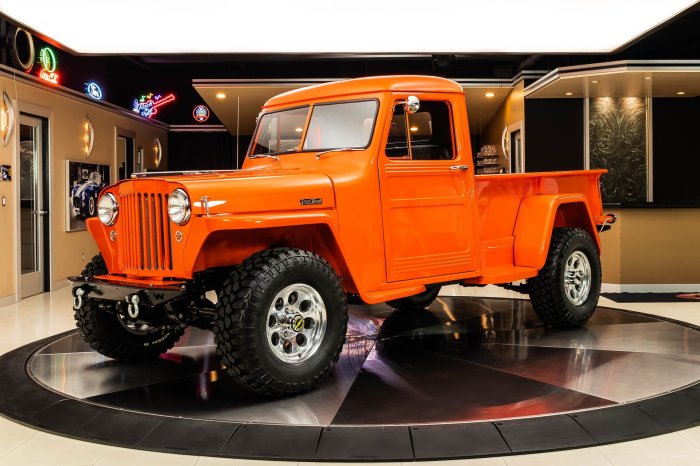
The 1949 Jeep Willys is a vehicle that has captured the imagination of many, and its iconic design is instantly recognizable. To further appreciate the beauty and versatility of this legendary vehicle, let’s delve into some visual representations of the 1949 Jeep Willys.
Visual Representations of the 1949 Jeep Willys
The following table showcases a selection of 1949 Jeep Willys models, each with a detailed description of its features and specifications:
| Image | Description | Year | Model |
|---|---|---|---|
| [Image of a 1949 Jeep Willys CJ-2A] | The CJ-2A was the civilian version of the Willys MB, featuring a longer wheelbase, a more comfortable interior, and a more powerful engine. It was a popular choice for farmers, ranchers, and other civilian users. | 1949 | CJ-2A |
| [Image of a 1949 Jeep Willys Wagon] | The Willys Wagon was a versatile vehicle that could be used for a variety of purposes, including transportation, hauling, and camping. It featured a spacious cargo area and a rugged construction. | 1949 | Wagon |
| [Image of a 1949 Jeep Willys Pickup] | The Willys Pickup was a popular choice for businesses and individuals who needed a reliable and durable work truck. It featured a strong frame and a powerful engine. | 1949 | Pickup |
Design Elements of the 1949 Jeep Willys
The 1949 Jeep Willys was a testament to simplicity and functionality. Its design was characterized by its rugged, utilitarian nature, with features like a flat-fendered body, a high-mounted windshield, and a distinctive seven-slot grille.
[Image of the 1949 Jeep Willys front grille]
Interior of the 1949 Jeep Willys
The interior of the 1949 Jeep Willys was designed for practicality and durability. The dashboard was simple and functional, featuring a speedometer, fuel gauge, and a few other essential instruments. The seats were basic but comfortable, and the interior was spacious enough for a few passengers.[Image of the 1949 Jeep Willys dashboard]
Final Wrap-Up

The 1949 Jeep Willys, more than just a vehicle, became a cultural icon. Its presence in movies, television shows, and literature solidified its place in popular culture, inspiring generations with its ruggedness and spirit of adventure. The Jeep brand, born from the 1949 model, continues to thrive, evolving and adapting while staying true to its roots, reminding us of the enduring legacy of this groundbreaking vehicle.